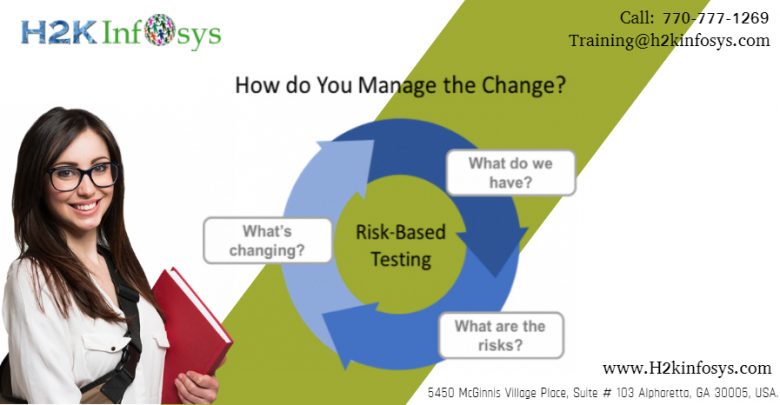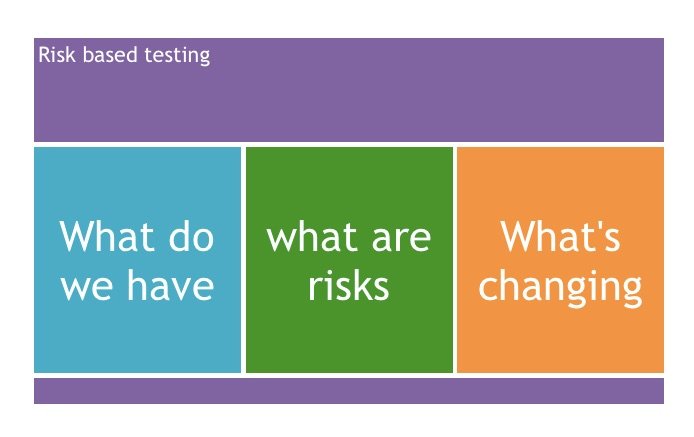
Risk based testing is performed based on the identification of risks involved in the project. Risk is the possibility of failure in the projects. Risk is the occurrence of the uncertain events with the positive or negative effect. This uncertain effect could have impact on business, cost, technical and quality targets of the projects.
Risks can be either positive or negative. They are explained as below.
Positive: It is the opportunity and help in business sustainability. For example investing in new projects, changing business processes etc.
Negative: these are the threats which recommend to be eliminated for the success of the project.
Risks can also be broadly classified as:
- Project risk
- Product risk
Project risk:
The project risk can be the problems other than those in the software. For example: incomplete or incorrect requirements, inaccurate estimates of resources, staff issues, inadequate skills of project team, business issues, political issues, technical issues, supplier issues and so on.
Product risk:
The product risk is associated with the risk in the specific quality characteristics of the software. The product risks include: defective software, software does not meet client requirements, defect in the structure of software, defect in quality characteristics of software etc
So generally the risk based testing is the process of giving priority to the feature’s project modules and functions under the application. It involves assessing the risk based on the complexity, business criticality, usage frequency and visible areas.
Risk management process:
The steps to understand the risk management process are
- Risk identification: This is done by conducting risk workshops, checklists, brain storming and interviewing. Risk register is a spread sheet which has a list of identified risks and its root causes. It is mainly used to track the risks throughout the life of the project.
- Risk Analysis: Once the list of risks are identified, the next step is to analyse them and filter the risk based on the significance.
- The risk response planning: After analysis we can decide, if the risks require any response. Some risks require response on project planning and some risk require response on project monitoring some does not require any response at all.
- Risk monitoring and control: Risk control and monitor process is used to identify the risks, monitor some residual risks, identify some new risks and update risk register and analyse the reason for change and execute risk response plan and monitor risk triggers.
Risk increases with change in technology, the size of the project, length of the project and shortage of appropriate skills. Risk analysis is performed when there are changes in requirements or new requirements requested by the client. The impact of risk is analysed for conducting the risk based testing.
How to manage Risk Based Testing?

Questions
- What are the advantages of risk based testing?






Risk based testing is the process of giving priority to the feature’s project modules and functions under the application. It involves assessing the risk based on the complexity, business criticality, usage frequency and visible areas.
Risk is the possibility of failure in the projects. Risk is the occurrence of the uncertain events with the positive or negative effect.
Risks can be either positive or negative.
Positive: It is the opportunity and help in business sustainability. For example investing in new projects, changing business processes etc.
Negative: these are the threats which recommend to be eliminated for the success of the project.
Advantages of Risk Based Testing:
>Improved quality – All of the critical functions of the application are tested.
>Running the tests in risk order gives the highest likelihood of discovering defects in severity order.
>Overall test goals, strategies and directions for testing can be focused and continuously adjusted against problem areas.
>Risks can be continuously monitored to know the status of the project and its quality.
>Associate the product risk to the requirement identifies gaps.
>Allocating test effort based on risk is the most efficient way to minimize the residual quality risk upon release (pick the right tests out of the infinite cloud of possible tests)
>Improve customer satisfaction – Due to customer involvement and good reporting and progress tracking.
>During testing, test reporting always takes place in a language (risks) that all stake-holder understands.
>Problem areas are discovered early. Preventive activities can be started immediately.
>Better strategies and test objects/cases can be selected.
>Provides a negotiating instrument to client and test manager similar when existing means are limited.
>Measuring test results based on risk will allow the organization to know the residual level of quality risk during test execution and to make smart release decisions.
>Give more focus on risks of the business project instead of the functionality of the information system.
Less but more efficient test cases can be specified.
>A better and more focused tests and risk analysis are performed.
>If schedule requires, dropping tests in reverse risk order reduces the test execution period with the least possible increase in quality risk (give up tests you worry about the least)
>Projects are able to define when to stop testing.
>Test cases can be reduced and focused on the most critical areas.
-Risk based testing helps in business sustainability. For example investing in new projects, changing business processes etc.
– Identifying the risks
-The risk analysis objective is to identify potential issues that could affect the project’s cost or outcome
– Risk monitoring and control: Risk control and monitor process is used to identify the risks, monitor some residual risks, identify some new risks and update risk register and analyse the reason for change and execute risk response plan and monitor risk triggers.
What are the advantages of risk based testing?
Risk based testing helps in the identification of the risks involved in the project. Risk is the possibility of failure in the project. It is because of the occurrence of an uncertain event which may have a positive effect or a negative effect. The impact will be on the business, cost , technical targets of the project. Negative – can be a threat whereas positive – can be an opportunity for the business.
The risk based testing helps in identifying :
-Project Risks- the issues related to staff, technical, inadequate skills of project team.
-Product Risks – the issues related to defective software, software not meeting the client requirements, defect in the structure of the software etc.
What are the advantages of risk based testing?
Risk based testing is performed based on the identification of risks involved in the project.
Risk is the possibility of failure in the projects or the occurrence of the uncertain
events with the positive or negative effect
The advantages of risk based testing:
– Projects are able to define when to stop testing.
– Test cases were reduced and focused on the most critical areas.
– A smaller number of test cases were needed, due to higher testing efficiency.
– Tests were more focused.
-can reduce cost as important problems were discovered early and preventive
Risk based testing is used to make sure that all the possible risks have been properly addressed. For example it helps in identifying the risk involved if the staff are inadequately skilled or changes in the business etc.
Positive: It is the opportunity and help in business sustainability. For example investing in new projects, changing business processes etc.
1. Risk is the possibility of failure in the projects.Risk is the occurrence of the uncertain events with the positive or negative effect.
Advantages of Risk based Testing:
– Time saving.
– Cost reduce.
– Tests will be more focused.
– Less test cases will be required.
– Analysis the risk.
– Analysis the skills of the team.
– Improve quality of system.
Risk based testing is used to make sure that all the possible risks have been properly addressed. For example it helps in identifying the risk involved if the staff are inadequately skilled or changes in the business etc.
Risk testing is performed based on identification of risks involved in the project. Early detection of risk testing will deliver good and quality software. reduces the time and cost of the project.
What are the advantages of risk based testing?
Risk based testing has the following advantages:
– Improves quality of product.
– Help gauge risks that may arise during the process of creating or implementing a software and helps plan ahead.
– Helps use of resources efficiently and effectively.
– Helps manage budgets.
– Helps maintain product consistency irrespective of changes to software or changes to the workflow.
. Identifying risks to system quality and using that knowledge of risk to guide testing planning, specification, preparation and execution.
. To provide opportunities to reduce the likelihood of defects, especially high-impact defects – and contingency – testing to identify work-around to make the defects that do get past us less painful.
. To measure how we respond to finding and removing defects in critical areas.
. It involves using risk analysis to identify proactive opportunities to remove or prevent defects through non-testing activities and to help us select which test activities to perform.
The advantages of Risk Based Testing is that it aims to prevent failures that may be caused due to incomplete or incorrect requirements, inaccurate estimates of resources, staff issues, inadequate skills of project team, business issues, political issues, technical issues, supplier issues etc.
1.<<Risk based testing is performed based on the identification of risks involved in the project.
<<Risk is the occurrence of the uncertain events with the positive or negative effect. This uncertain effect could have impact on business, cost, technical and quality targets of the projects.
<<It is the opportunity and help in business sustainability. For example investing in new projects, changing business processes etc.
<<the risk based testing is the process of giving priority to the feature’s project modules and functions under the application
<<It involves assessing the risk based on the complexity, business criticality, usage frequency and visible areas.
Advantages of risk based testing:
Will be able to define more clearly when to stop testing
Test cases will be reduced and focused on the most critical areas
A smaller number of test cases will be needed, due to higher testing efficiency
Tests will be more focused
Cost will be reduced, as important problems will be discovered early and preventive activities started sooner
Overall test goals, strategies, and directions will get improved
Testing mainly will be focused on the most important areas
Testing will get continuously adjusted against problematic areas
dvantages of risk-based testing:
1). Risk based testing is performed based on the identification of risks involved that cause the possibility of failure in the projects.
2). Identifying the risks earlier that reduce the cost and preventive activities started sooner helps to prevents project failure.
3). Risk based testing mainly focused on the most important and critical areas of the project.
4). Overall test goals, strategies, and directions improved.
Risk based testing is performed based on the identification of risks involved in the project. Risk is the possibility of failure in the projects. Risk is the occurrence of the uncertain events with the positive or negative effect. This uncertain effect could have impact on business, cost, technical and quality targets of the projects.
Risk based testing helps the entire development and testing process by managing the budget, planning ahead to use the available resources efficiently, spot potentially weak areas, and improve the overall quality of the product. It directs testing to the areas that are likely to need it most, and therefore spot and fix the most likely defects.
Advantages of risk-based testing: Risk based testing is based on the identification of risks involved in the project. Risks can be positive or negative. The advantage of risk-based testing is in identifying the risks either positive or negative which can avoid uncertain effect on the business, projects, products, costs etc.
Risk based testing is it identifies the risks involved in the project that can have impact on business, cost, technical, and quality. There is also risk of the product side such as a lack of quality, usage frequency and complexity. The advantage of using this method is the risks are already identified during this method and checked through to be as positive as possible. If done correctly it could save money, time, and increase quality of product.
1. The advantages of risk-based testing:
i. Analyzes the impact of risk
ii. Identifies, analyzes, and monitors risks.
iii. Helps prevent negative impacts on business, cost, as well as on technical and quality targets of the project.
iv. Helps prevent defective software, software that does not meet the requirements of the client, defects in the software structure, defects in the quality characteristics of the software, etc.